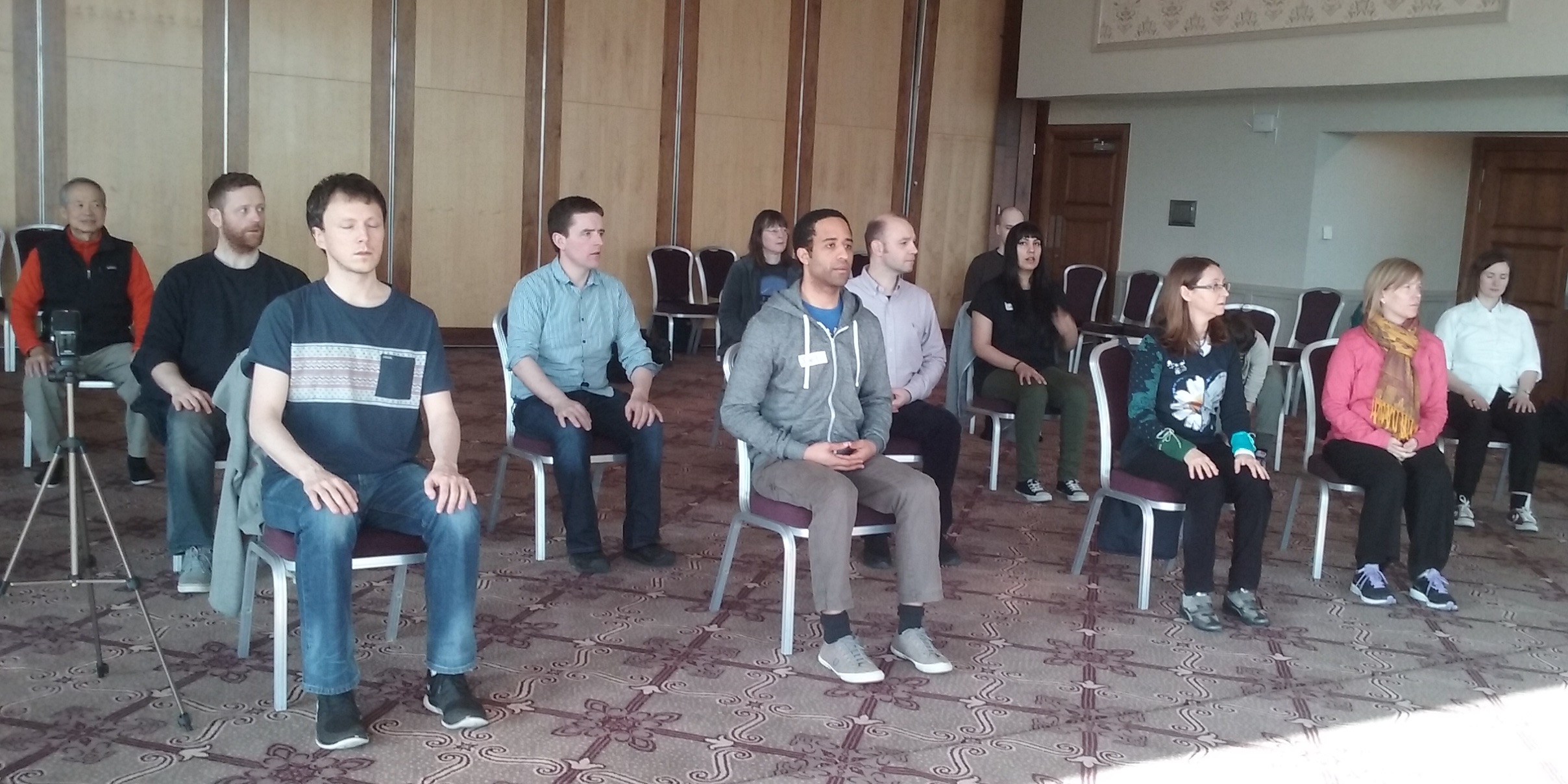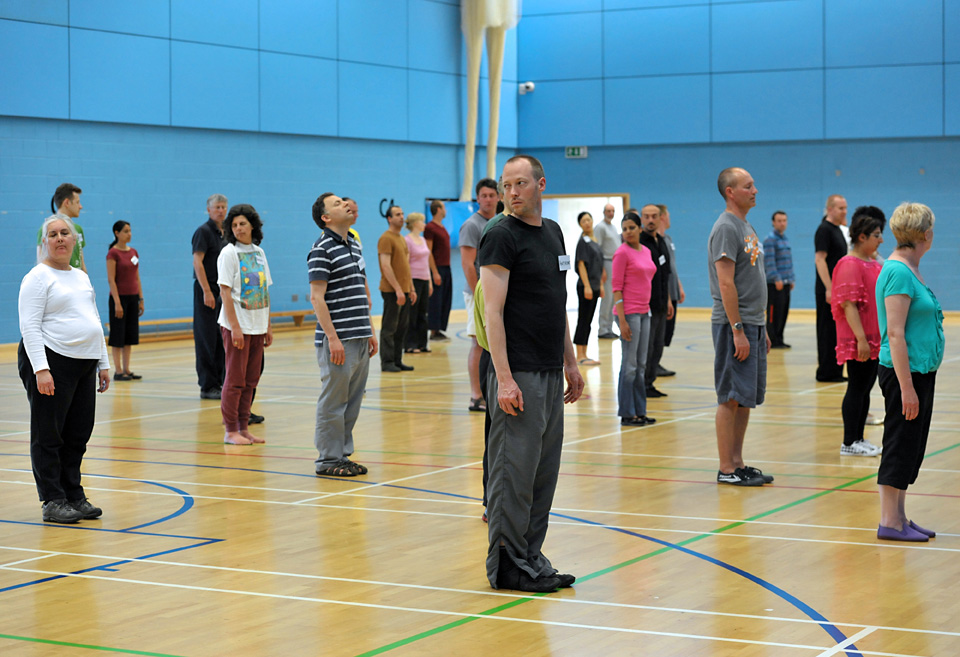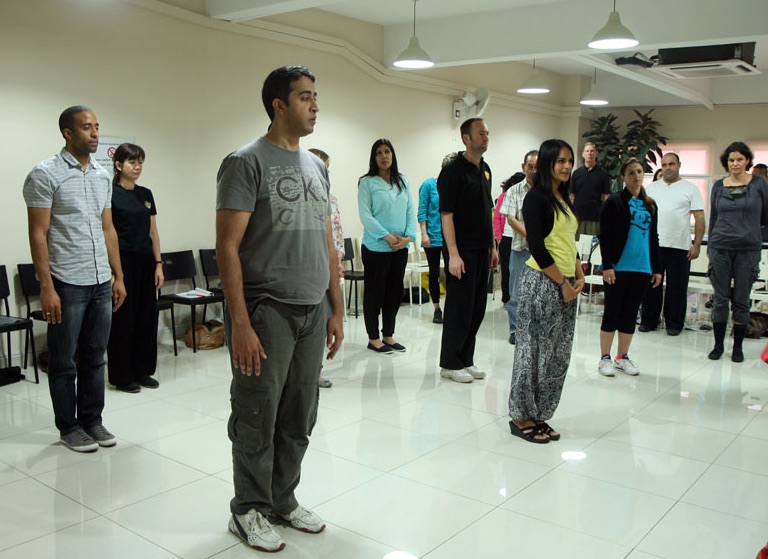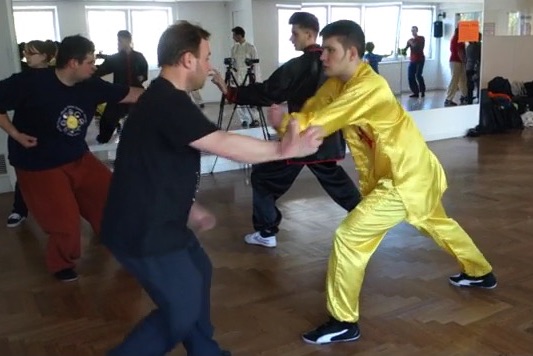SELECTION OF QUESTIONS AND ANSWERS
JUNE 2017 PART 1

Course participants at an Intensive Zen Course in Dublin in 2016
Question 1
Can you please explain "enlightenment" in the Buddhist context, and the word "enlightenment" in English?
— Richard, United Kingdom
Answer
The term "Enlightenment" in Buddhist philosophy means perfectly merging with the Cosmic Reality where there is no knower and the known. In Western culture it means returning to God the Holly Spirit.
In English the word "enlightenment", like the age of enlightenment, has a different meaning. It means having a clear intellectual understanding.
It is worthy of note that intellectualization is not present in the Buddhist concept of Enlightenment. Once there is intellectualization, or thought, the transecendental Cosmic Reality will be transformed into the phenomenal world where there are knowers and the known.
The paramount path to Enlightenment is meditation, which means the training of mind or spirit. The mind is trained to the supreme level where it recognizes that the personal mind is an illusion, that actually there is only all mind. In Western culture, it means there is only God and nothing else. In scientific terms, it is the universal spread of energy.
Question 2
I think some of us also have some difficulty with the word "meditation". In our school you often ask us not to intellectualize when we meditate. But the word "meditate" means "to think of the underlying reason", which requires intellectualization.
Answer
This is a very good comment.
I recall that when I first taught meditation to English speaking students more than 30 years ago, I had difficulty translating the Chinese words "zuo chan" and "jing zuo" to them. I translated the words as "meditation", as the term had become established, although I was aware that "to meditate" might mean "to think", but in our form of meditation we didn't think.
Now, with better hindsight, I may use terms like "sitting in Zen" or "sitting silently", which are their literal meaning.
The term "meditation" was first used by early Christian fathers in spiritual cultivation. In meditation, they thought of God's words, and reflected on them. Later, when similar forms of spiritual cultivation came from the East, the term "meditation" was also used because their outward forms appeared similar, though in some forms of Eastern meditation, like in Zen, it was advocated to avoid thinking.
Zen is closely associated with our school. So in our meditation, thinking is often avoided.
We also use a lot of Taoist meditation. In Taoist meditation, intuitive thinking is used, like thinking of the dan tian. It should be noted that intuitive thinking is not intellectualization.
The term "visualization" may also need some brief explanation. We use this term because it has become established. But when we "visualize", it is more of having an intuitive thought, and not having a clear image.
For example, in sparring practice we may visualize an opponent kicking us. We just have a gentle thought of a kick coming. It is not necessary, in fact it would be detrimental, to have a clear image of the dress an opponent is wearing, and how he moves in to kick us.

Visualization is much used in Bone-Marrow Cleansing
Question 3
I have learnt Six Healing Sounds and Microcosmic Orbit. Can I practice all on one day, like Lifting the Sky, then Microcosmic Orbit and Six Healing Sounds?
I have learnt from teachers and not by myself. But I would like your advice.
— Moe, United Kingdom
Answer
You didn't indicate whether you learned from me or any of our certified instructors. If you have learned from me or any one of us, just practice what you have learned from our school. It is unnecessary to practice the other exercises even if these other exercises are practiced correctly.
You would have noticed that we have become so cost-effective now that I advise our students to aim at only 30% of what they attained at a course with me or when they learned from their sifu. Just getting 30% of the benefits is more than enough for their needs of practicing chi kung, like overcoming illness, and attaining good health, vitality and longevity. If they get more results everyday, they may over-train.
If you haven't learnt from us, whether you should practice the other chi kung exercises depends on how competent your teachers are. I am not referring to your teachers now, but referring to teachers in general. Most chi kung teachers today are not competent, though some of them are actually very nice people. Practicing these exercises not only bring you no chi kung benefits, but may also harm yourself, often without your and your teachers knowing.
A competent teacher, for example, will not teach Micro-Obit to a student who does not know whether he should practice this exercise with other exercises. In other words, if a student is taught an advanced exercise like the Micro-Obit, he will be advanced enough to know how and when to practice it.
Similarly a competent teacher would not teach a student who is not advanced enough, the Six Healing Sounds. The Six Healing Sounds Chi Kung has a special difficulty, even for advanced students.
These six sounds may be represented as "su shu hu si chu xi". There are also other ways following other systems of lettering, to represent the six healing sounds in writing. There are easily more than 10 different ways to pronounce each of the six sounds, which means there are very high chances of not pronouncing them correctly. If you realize this fact alone, you may wonder why a responsible master would post these sounds on the internet or in books and recommend others to practice them.
Question 4
In "Carrying the Moon" can I bend my knee a little so that it is easier on my back? For prostate issues would "Carrying the Moon" and "Rotating Knees" be the best forms to do?
— Vikas, India
Answer
Yes, you can bend your knees a little when performing "Carrying the Moon"
For prostate issue, chi flow is the best answer. You can perform any suitable chi kung techniques, like "Carrying the Moon", "Rotating Knees" and "Lifting the Sky", then enjoy a chi flow which will overcome the prostate problem.

Heart-to heart transmission of skills in an Intensive Chi Kung Course in Kuala Lumpur
Question 5
Sifu, you said that we could achieve in one month what it would take you a year to achieve. Why is this so? Do you do anything special, like giving us chi?
— Juan, Spain
Answer
It is because of my more effective teaching methodology. I don't purposely give you chi, though my large chi field may enhance your result. When I walk past, for example, many students who were previously motionless, started to move due to my chi stimulating their chi field. For this reason, sometimes I purposely stand at a corner of the hall so that you would depend on your own chi flow to progress.
There are a few factors in my improved teaching methodology. One important factor was differentiating skills from techniques. During my own student's days, like most practitioners today, I thought that result was due to my diligent practice of appropriate techniques. In other words, if I practiced the techniques diligently, I would derive the expected result.
Later, during my own teaching in my earlier years, I discovered that besides the right techniques, more importantly successful practitioners must have the necessary skills. This is very obvious in both chi kung and kungfu training, but most people are unaware of it. Most chi kung and kungfu practitioners have the right techniques, but most of them (outside our school) cannot generate an energy flow and cannot apply their kungfu for combat. It is because they do not have the necessary skills.
Then, why a small percentage of students can generate an energy flow and apply their kungfu for combat. This is because, due to their diligent daily training, they develop the necessary skills unknowingly. Suppose that for three days in a month, their training has become so ideal that the necessary skills present themselves. These are the days when they can derive benefits form their training. So, in a year they would have successful training for 30 days. Eventually these students become masters.
But our students have the techniques and the skills every day. They can train successfully for 30 days in a month. Hence our students now can attain in one month what I, like other students today, needed a year.
Actually the result of our students in a month is more than the result of other students in a year. This is because as our students have benefits every day, they have the advantage of accumulated progress. As the three days a month of other students are too far apart, they do not have the advantage of accumulated progress although they may practice every day.
Another important reason why our students can have the skills on the very first day is because I transmit the skills to them from heart to heart. Other students have to develop the skills themselves from their own practice.
Our instructors can also transmit skills from heart to heart. But because their students stay with them for a few months in a regular class, but my students stay with me for only a few hours in a regional course, for the benefit of the students, our instructors allow the students to develop the skills on their own instead of transmitting the skills to them.
Question 6
In terms of past lives and next lives, who is to say that they actually occur in accordance with our linear perception of time. Could our next life be the 1700s? Our previous life in the 2300s?
— Jeremy, USA
Answer
I didn't record the names of those who said that past lives and next lives occurred in accordance with our linear perception of time, but I believe there are more people by a big margin holding this opinion than the reverse opinion.
Among those who believe in the linear perception of time, there are also far more people believing that time goes forward than time goes backward. So, according to the majority view, your next life in more likely to be in the 2300s than in the 1700s, or any time after the present moment than before the present moment.
Even those who talk about linear time going backward, or cyclic time or any other concepts of time, including the concept that time is a human construct and not real, and neuclear physicists whose concept of time is very different from that of ordinary persons, use linear time going forward in their daily life. If they go to bed on Wednesday night, for example, and wake up the next morning, it is Thursday, not Tuesday, or ten years earlier.

A course on the Five-Animal Set in Vienna in 2016
Question 7
Is there a technique where all the Shaolin five animals are trained?
— Christian, USA
Answer
Yes, for you and those who have successfully completed the Five-Animal Set course, you can use any technique to manifest these beneficial qualities, not only techniques in the Five-Animal Set but in all kungfu sets and in your daily life.. Those who have not learned these skills will be unable to do so.
As an analogy, those who have the skills to drive a car forward or bakcward, park a car, drive it uphill or downhill, on an expressway or to a market place, will be able to do so with any car. Those who don't have these skills will be unable to do so regardless of what car they have.
The dragon form trains mind, the snake form trains energy, the tiger form trains internal force, the leopard form trains speed, and the crane form trains elegance. After a practitioner has successfully completed the course on the Five-Animal Set, when he performs a dragon form, for example, not only he has presence of mind, but also he has energy flow, internal force, speed and elegance.
Similarly, when he performs any particular form, not only he manifests the special quality of that form, he also manifests the qualities of all the other forms. When he performs any pattern from other kungfu set, he can also manifest these qualities.
In his daily life, whatever he does, he can also manifest presence of mind, energy flow, internal force, speed and elegance. Initially he may have to make an effort to do so. But gradually these qualities will manifest themselves spontaneously.
We do not practice kungfu just for combat, we practice kungfu to enrich our dailu life.
Question 8
Can you please tell us more about the 12 types of bridge-force of the Iron Wire Set?
Answer
In the Iron Wire Set, a famous Southern Shaolin kungfu set to develop tremendous internal force, there are 12 types of force, known as bridge-force. They are hard-force, soft-force, press-force, straight-force, separate-force, stable-force, inch-force, lift-force, keep-force, circulate-force. control-force, and match-force
Briefly, hard-force is powerful, like a ramming punch. Soft-force is flowing, like throwing an opponent to the ground. Press-force is pressing in, like forcing an opponent against a wall.
Straight-force is going straight in, like a thrust to the throat. Separate-force is opening, like opening an opponent's defence. Stable-force is to subdue an opponent, like a taming-hand to prevent an opponent attacking.
Inch-force is exploded within a very short distance, like striking an opponent within in close quarters. Lift-force is to raise an opponent's movement, like lifting his hands to strike him. Keep-force is to contain an opponent's attack, like keeping an opponent's attack so that he may not withdraw it.
Circulate-force is to channel the force to a chosen place, like channeling the force to a particular attack. Control-force is to control an opponent, like gripping an opponent so that he cannot move away. Match-force is to meet an opponent's force, like "leaning" your arm onto an opponent's punch.
These 12 types of force are actually the same force but used differently. When the force is used to pressing into an opponent, we call it press-force. When the same force is used to match an opponent's attack, we call it match-force.
An analogy is money. We may reserve some money for food, and call it food money. We may reserve some money for entertainment, and call it entertainment money. But all come from the same source and are the same money.
LINKS
Selected Reading
- Is Enlightenment Sudden or Gradual?
- Getting the Best Benefits from your Training
- A Stable Foundation to Fulfill any Aspiration
- Northern Shaolin Seven-Star Set
- Simply Delicious
